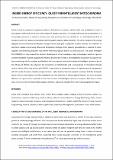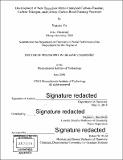| dc.contributor.author | DATTA, SHOUMEN | |
| dc.date.accessioned | 2009-06-04T14:41:01Z | |
| dc.date.available | 2009-06-04T14:41:01Z | |
| dc.date.issued | 2009-06-04T14:41:01Z | |
| dc.identifier.uri | http://hdl.handle.net/1721.1/45552 | |
| dc.description | Using data from energy measurements, in addition to other policy and parameters, INGRID may spur economic growth by catalysing energy efficiency. Users may pay even less for electricity. Ingrid may accumulate carbon micro-credits for her i-house through an entrepreneurial environmental cooperative for energy eBusiness (which trades in carbon options) and use banked carbon credits to offset the carbon footprint each time she needs to fly. INGRID pursues the intelligent mitochondria, an era when Jane and Joe can generate energy from a variety of sources including renewables and profit from auctioning their excess (capacity) electricity on the hypothetical portal power.on.eBay while contributing to the global deal to reduce greenhouse gas (GHG) emissions. Micro-generation of electricity, micro-sales and distribution via INGRID may have positive economic consequences for some rural regions and eventually, for some remote parts of the world. Rural economic revitalization commences with the investment to generate energy from rural areas by harvesting unused natural resources (wind, solar) and agri-waste (biofuels). Non-fossil energy may find its way to power the air conditioner in room 8080 of a city-based conglomerate if waste-lands can grow oil weeds. INGRID requires a mechanical mitochondria to evolve as the regulatory hub to balance energy needs, exercise control and optimize efficiency. Today, we may still hear the question: are you connected to the Internet? In the future, the question may be: are you connected to the INGRID? | en |
| dc.description.abstract | Policies based on empirical assumptions without a foundation in granular real-time data may be limited in scope. It may sputter ineffectively in its role as the engine of energy economics. For energy efficiency and conservation, it is increasingly necessary to invest in systems, tools and practices that can facilitate bi- or multi-directional flow of energy to control or balance consumption with the goal to reduce carbon footprint. The central dogma of an energy oligopoly and uni-directional distribution through the electricity grid is poised for a radical overhaul. An “internet” of electricity capable of executing differential distribution strategies from capacity generated by a network of micro-suppliers and electricity producers may evolve from the proposed Smart Grid infrastructure. The future Intelligent Grid (INGRID) is a step toward the obvious. Development of methodologies using technologies based on rigorous scientific standards must be coupled with effective dissemination of tools and adopted by consumers to acquire real-time monitoring data for analyses and feedback decision support. Automation driven by intelligent systems is key to the efficacy of INGRID. We advocate the emergence of mitochondria and a convergence of innovation through service science, which may evolve with INGRID. It represents an amorphous nexus of engineering and management with the needs of society, industry and government. Higher levels of decision support, necessary both for strategists (policy makers) and engineers (INGRID operators), may be impotent or without global impact if we fail to promote diffusion of a “grass-roots” approach to seed one or more methodologies necessary to acquire data from a critical mass of users in each environmental category (domestic, industrial, hospital) from each major geographical region. | en |
| dc.description.sponsorship | MIT Forum | en |
| dc.language.iso | en | en |
| dc.relation.ispartofseries | ESSAYS IN ENERGY; IV | |
| dc.relation.replaces | http://hdl.handle.net/1721.1/45550 | |
| dc.relation.uri | http://hdl.handle.net/1721.1/45550 | |
| dc.subject | Smart Grid, Intelligent Grid, INGRID, IPv6, Carbon Micro-Credits, Carbon Trading, Carbon Emissions, Carbon Tax, Carbonomics, Internet of Electricity, Service Science, Wireless Sensor Networks, Energy Monitoring, Policy, Carbon Footprint, Green House Gas Emissions, Clean Development Mechanism (CDM), 6LoWPAN, Dynamic Pricing, Dynamic Programming, Intuitive Software, Carbon Supply Chain, Operations Management, Econometric Tools, Mitochondria | en |
| dc.title | INGRID ENERGY EFFICIENCY: QUEST FOR INTELLIGENT MITOCHONDRIA | en |
| dc.title.alternative | ESSAYS IN ENERGY | en |
| dc.type | Working Paper | en |
| dc.contributor.department | Massachusetts Institute of Technology. Auto-ID Laboratory | |

